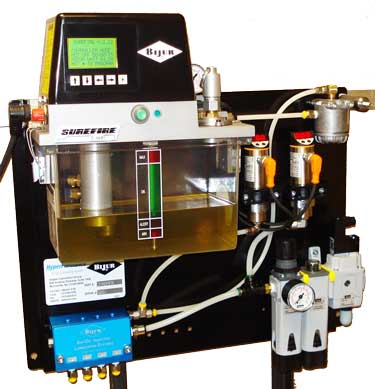For a piece of equipment that is designed to rotate at thousands of RPMs, it may seem obvious that proper lubrication is a major factor in the health of spindles.
In practice, things are a bit different. While everyone knows that improper lubrication maintenance can lead to spindle failure, it can seem like a far-off possibility as opposed to a certainty. Plus, as a largely unseen aspect of spindle operation, lubrication is a little too easy to put out of mind. On top of that, there are factors such as downtime and cost that may lead some to shirk proper lubrication.
No. The truth is that, despite its obvious importance, there are more people who neglect proper spindle lubrication than there are who don’t.
Importance of Spindle Lubrication
 If you asked someone why spindle lubrication was important and they said “lubrication helps spindles spin,” that would be technically true — but it misses a lot of quite important nuance.
If you asked someone why spindle lubrication was important and they said “lubrication helps spindles spin,” that would be technically true — but it misses a lot of quite important nuance.
The most important aspects of spindle operation — in terms of functionality, maximum speed; in terms of spindle health, operating temperature and vibration levels — all depend on proper lubrication. Neglecting lubrication will not only shorten the lives of your spindle’s bearings, but it will also reduce the quality of the products it produces.
3 Basics of Spindle Lubrication
Luckily, for properly motivated shop managers and owners, bare-bones spindle lubrication is fairly straightforward and can go quite a long way. There are three basic steps that, contrary to popular perception, can be easily and inexpensively administered.
1) Lubrication Type
You can’t take any old lubricant and put it into your spindle.
Each spindle will have a specific type of lubricant, with exacting compatibility, viscosity, and even quality-threshold requirements. Lubricating your spindle with oil that doesn’t meet the proper requirements will hasten bearing wear. You also can’t safely reuse oil, even if it “looks clean” — if it’s been used, it already has microscopic scraps of metal in it that will wreak havoc on your bearings.
You might save a few bucks switching to a lower-grade lubricant, but the costs of bearing failure will be much greater.
2) Lubrication Amount
From the repairs that come through our shop, it’s clear to us that the most common error in spindle lubrication is using an inappropriate amount of lubricant. Both too little and too much can cause issues, though using too little will lead to more serious problems, and more quickly.
Common symptoms of too little lubricant are rolling element and raceway deterioration, and cage fragmentation — all of which will lead to outright bearing failure if not diagnosed and repaired.
3) Lubrication Timing
Applying too often can cause issues like leaks and actually hurt spindle performance. Applying too rarely leads to the same potentially catastrophic issues as using too little — element deterioration, cracking, fragmentation, and ultimate failure.
Every spindle comes with both a lubrication schedule and service schedule. Follow them.
A Few Extra Tips
Those three steps are the absolute bare minimum. Spindle lubrication is far too complex a task to distill into a single blog. If you’ve read this far, chances are that you’re anxious to improve your lubrication practices. Using the right lubricant, the right amount of it, and at the right times are a solid foundation.
Here are a few other things you can do to keep your spindles running smoothly between professional services (which we recommend annually):
- Check lubricator hoses regularly for kinks and obstructions — if lubrication is not flowing freely, your bearings are suffering
- Calibrate air pressure drop rates on drip systems regularly
- Warm up your spindles if they’ve been idle for 12 or more hours — this is especially important for grease-lubricated spindles
- Ensure all drainage holes face down
- Seal all fittings — hydraulic, pneumatic, and electrical — with sealant, not tape
Like the moving elements of any machine, spindle bearings will one day fail. But if you take care of them properly — especially in regards to lubrication — you will get a good, full life out of them.
Not to mention you’ll avoid serious, costly equipment failure and unplanned downtime. While we understand that it may sometimes seem like it, the money you save now will not make up for those costs.

